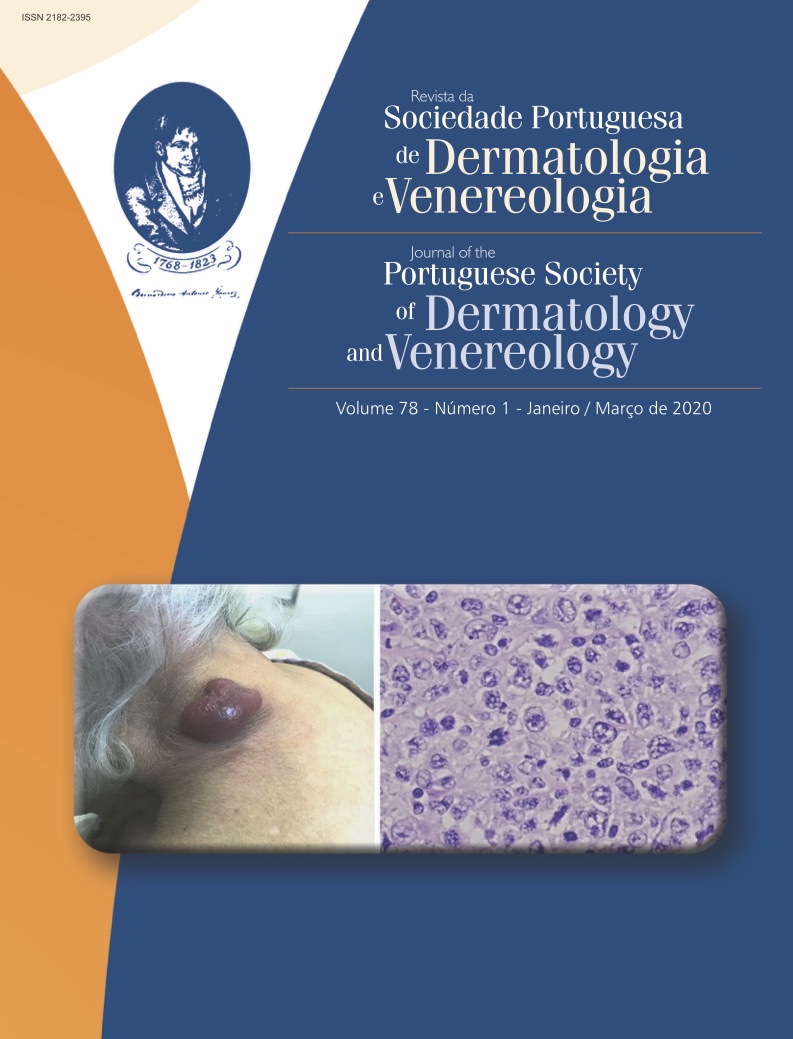Valor Preditivo do Primeiro Cancro Cutâneo Não-Melanoma: Estudo Retrospetivo
Resumo
Introdução: Os doentes com antecedentes pessoais de cancro cutâneo não melanoma têm um risco aumentado de desenvolver outro cancro cutâneo e alguns estudos sugerem que o tipo histológico do primeiro tumor pode ser preditor dos subsequentemente diagnosticados. O objetivo deste estudo foi avaliar a correlação entre o tipo histológico do primeiro cancro cutâneo não-melanoma e os subsequentemente diagnosticados no mesmo hospedeiro, em indivíduos imunocompetentes e com diferentes causas de imunodepressão.
Métodos: Estudo retrospetivo em que foram incluídos todos os doentes sem antecedentes de cancro cutâneo, com o diagnóstico de dois ou mais cancros cutâneos não-melanoma entre 1 de Janeiro de 2008 e 31 de Dezembro de 2017.
Resultados: Incluídos um total de 413 doentes, 51 (12,4%) dos quais imunodeprimidos. Verificou-se uma associação significativa entre o tipo histológico do primeiro e dos cancros cutâneos não-melanoma subsequentemente diagnosticados, quer em doentes imunocompetentes, quer em imunodeprimidos, com uma maior probabilidade de desenvolver um tumor do mesmo tipo histológico (p<0,001). Esta associação foi também significativa em doentes com uma neoplasia hematológica. O intervalo médio entre os dois diagnósticos foi de 30 meses (intervalo 7-111). Quarenta e três doentes (10,4%) apresentaram um tumor subsequente após mais de cinco anos de seguimento.
Conclusões: O tipo histológico do primeiro cancro cutâneo não-melanoma foi preditor do risco de desenvolver um tumor do mesmo tipo. Pela primeira vez, esta correlação foi identificada em doentes com uma neoplasia hematológica. Os doentes de alto risco devem ter um seguimento prolongado de pelo menos dez anos.
Downloads
Referências
Global Burden of Disease Cancer Collaboration. Global, Regional, and National Cancer Incidence, Mortality, Years of Life Lost, Years Lived With Disability, and Disability-Adjusted Life-years for 32 Cancer Groups, 1990 to 2015A Systematic Analysis for the Global Burden of Disease Study. JAMA Oncol. 2017;3:524-48. doi: 10.1001/jamaoncol.2016.5688.
Lomas A, Leonardi-Bee J, Bath-Hextall F. A systematic review of worldwide incidence of nonmelanoma skin cancer. Br J Dermatol. 2012;166:1069-80. doi: 10.1111/j.1365-2133.2012.10830.x.
Rogers HW, Weinstock MA, Feldman SR, Coldiron BM. Incidence estimate of nonmelanoma skin cancer (keratinocyte carcinomas) in the US Population, 2012. JAMA Dermatol. 2015;151:1081-6. doi: 10.1001/jamadermatol. 2015.1187.
Marcil I, Stern RS. Risk of developing a subsequent nonmelanoma skin cancer in patients with a history of nonmelanoma skin cancer: a critical review of the literature and meta-analysis. Arch Dermatol. 2000;136:1524-30.
Flohil SC, van der Leest RJ, Arends LR, de Vries E, Nijsten T. Risk of subsequent cutaneous malignancy in patients with prior keratinocyte carcinoma: a systematic review and meta-analysis. Eur J Cancer. 2013;49:2365-75. doi: 10.1016/j.ejca.2013.03.010.
Duarte AF, Sousa-Pinto B, Haneke E, Correia O. Risk factors for development of new skin neoplasms in patients with past history of skin cancer: A survival analysis. Sci Rep. 2018;8:15744. doi: 10.1038/s41598-018-33763-7.
Tessari G, Naldi L, Boschiero L, Nacchia F, Fior F, Forni A, et al. Incidence and clinical predictors of a subsequent nonmelanoma skin cancer in solid organ transplant recipients with a first nonmelanoma skin cancer: a multicenter cohort study. Arch Dermatol. 2010;146:294-9. doi: 10.1001/archdermatol.2009.377.
Wisgerhof HC, Edelbroek JR, de Fijter JW, Haasnoot GW, Claas FH, Willemze R, et al. Subsequent squamous-and basal-cell carcinomas in kidney-transplant recipients after the first skin cancer: cumulative incidence and risk factors. Transplantation. 2010;89:1231-8. doi: 10.1097/TP.0b013e3181d84cdc
Subramaniam P, Olsen CM, Thompson BS, Neale RE; QSkin Sun and Health Study Investigators. Anatomical distributions of basal cell carcinoma and squamous cell carcinoma in a population-based study in Queensland, Australia. JAMA Dermatol. 2017;153:175-82. doi: 10.1001/jamadermatol.2016.4070.
Lanoue J, Chen C, Goldenberg G. Actinic keratosis as a marker of field cancerization in excision specimens of cutaneous malignancies. Cutis. 2016;97:415-20.
Wehner MR, Linos E, Parvataneni R, et al. Timing of subsequent new tumors in patients who present with basal cell carcinoma or cutaneous squamous cell carcinoma. JAMA Dermatol. 2015;151(4):382-388.
Todos os artigos desta revista são de acesso aberto sob a licença internacional Creative Commons Attribution-NonCommercial 4.0 (CC BY-NC 4.0).








